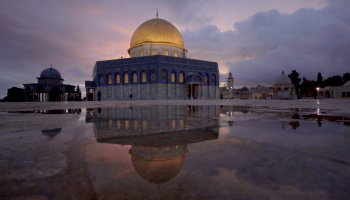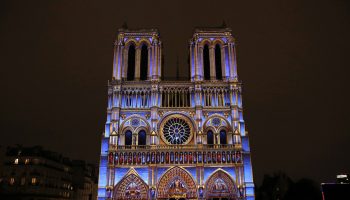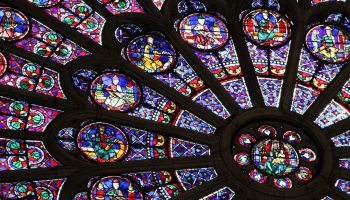On Monday, April 15, 2019, fires broke out in the Cathedral of Notre-Dame in Paris and the Al-Aqsa Mosque in Jerusalem. Thankfully, the mosque was left largely undamaged. The Cathedral was not so lucky. The Public Medievalist is publishing reactions to and discussions of that day’s events and their aftermath under the title A Day of Fire.
The first contribution is by Lisa Fagin Davis.
I fell in love with Notre Dame the moment I first saw her, well before I became a medievalist. It was 1984. I was celebrating my high school graduation by skipping around France and England with two friends; we hit the highlights, feeling independent and nearly grown. We had been at the Louvre that day, reveling in our feelings of newfound sophistication and good taste. We ducked through the archway, turned left at the river, crossed the bridge to the Île de la Cité, and… wham. She stopped me in my tracks.

Bright and beautiful in the late afternoon sun, she left me humbled, and grateful. This wasn’t for religious reasons—I’m Jewish, after all. But I was left in awe of this wondrous human achievement, the sheer magnificence and beauty. I imagined the masons, the sculptors, the stained-glass makers, the architects and the engineers who had devoted their lives to creating her. I imagined the millions upon millions of worshippers and tourists who had passed through those portals over the centuries. I was only one among them. I was tiny and insignificant in comparison to this massive, extraordinary structure that would surely stand forever. Humbling, indeed.
Thirty-five years later—years which included art history coursework, a PhD in Medieval Studies, and multiple visits to Paris—I sat in front of the television on Monday in shock and horror, sickened and grieving, as Notre Dame—the first medieval Thing I ever loved—burned. Like so many of my medievalist friends and colleagues, I frantically took to the internet looking for up-to-the-minute images and reporting.
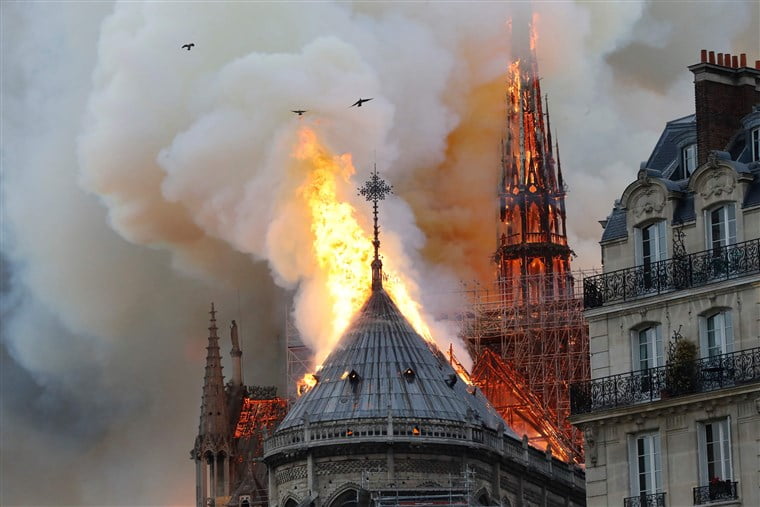
The Cathedral was evacuated as soon as the smoke was spotted. Had anyone been hurt? And what would become of the structure? The roof of the Cathedral is not like that of a modern house. It’s layered: medieval masonry vaults form the ceiling; there is an attic space above the ceiling that is defined by massive twelfth-century wooden beams of the roofline. And on top of that, the whole thing is covered over with lead and slate. If the vaulted ceiling collapsed beneath the crushing weight of the burning roof and beams, the interior of the Cathedral would be exposed and gutted. Would the vaults hold?
And what of the art within, the relics, the sculpture? The rose windows at the north, south, and west entrances are famous—even iconic. I was worried about them, of course. But the piece that has always spoken to me most is the exquisite fourteenth-century statue of the Virgin and Child, known as “Our Lady of Paris.” The sculpture stands on a tall pedestal in the southeast corner of the crossing—the intersection of nave and transept: would she survive the night?

Sailko (CC BY 2.5).
Rumors were swirling. Information was coming fast. I was Tweeting madly. It was impossible to keep up. The roof had collapsed. No, the roof was intact. The windows were shattered. No, the windows were unharmed. The relics were ashes. The relics were safe. The only certainty was what everyone could see: the roof in flames. Slowly but inexorably, the iconic nineteenth-century central spire toppled, collapsing in a rush of flame and dark smoke. I sat on my couch and wept.
But I am a medievalist. Why should I weep for a nineteenth-century spire? Because, like all medievalists, I understand and value the life cycle of Medieval Things.
Nothing makes it from the Middle Ages to the 21st century without being transformed along the way. Manuscripts are rebound, pulled apart, stuck together. A piece of sculpture loses a limb, or its polychrome—the original multi-colored pigment that once adorned it—fades. A cathedral is, at its heart, a compilation, unfinished, always in the process of becoming. This is true not just in its structure, but in its functional and decorative elements—the art and artifacts that inspire awe and facilitate worship.
Since the foundation stones were laid in 1163, Notre Dame has been anything but static. It was built over the course of two centuries, but was never really finished. Portions were torn down and rebuilt in the early modern period. It fell into disrepair in the nineteenth century, saved, in part, by publicity generated by the publication of Victor Hugo’s The Hunchback of Notre Dame, which spurred restoration efforts. The iconic central spire was added in the late nineteenth century. The relics, art, and artifacts displayed and stored in the Cathedral represent every century from the twelfth to the twentieth. On Monday we lost twelfth-century timber, thirteenth-century glass, late-medieval and early-modern constructs, nineteenth-century additions, and modern as well as medieval treasures. We weep for them all.
And then there is the intangible loss: the 856 years to which those stones bear witness. The music composed for and performed in that glorious soaring space, the historic events, the everyday personal moments of prayer and awe and quiet contemplation. The Cathedral is full of memory. Can the wreckage retain the echo of human experience?
In the light of day on Tuesday morning, photos from the interior of the Cathedral showed that the worst had been avoided. The vaults had done what they were meant to do: with the exception of a section at the crossing, which had been caved in by the falling spire, the vaulting held firm. The vaults protected the interior of the Cathedral as the wooden beams above it collapsed. Heroic firefighters, priests, and passers-by had formed a bucket-brigade to evacuate precious relics and artifacts. Only one firefighter had been injured. One photo showed the north rose window, unbroken and glowing in the morning sun. Another showed, “Our Lady of Paris:” intact, with a pile of rubble at her feet. She had, indeed, survived the night. And again, I wept.
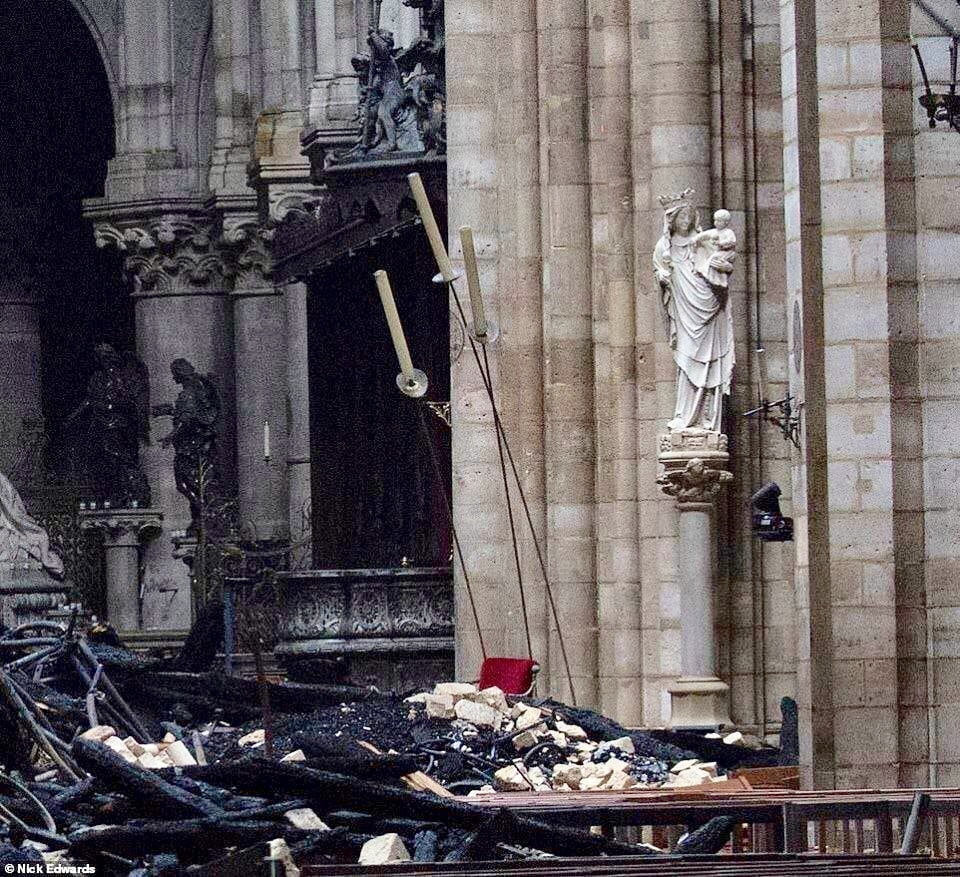
Notre Dame is the accumulation of 856 years of human engineering, art, design, faith, inspiration, and ingenuity. She will continue Becoming as the rebuilding begins. But much has been lost—we will likely not know for several days which artifacts, treasures, and relics survived and which were lost. They were an integral part of the Notre Dame we knew, and once lost cannot be replaced. But the Cathedral will be repaired, a new roof set in place. The surviving relics will be restored to their places of honor, and the worshippers and tourists will return. The organ will be cleaned, the choir will again chant hymns and psalms. Something new will rise, rightly so, in keeping with her long and complex history. She will still stop me in my tracks, but the Notre Dame we knew and loved is gone. And so we weep.
If you enjoyed that article, please share it with your history-loving friends on Facebook, or on Twitter! And be sure to subscribe here to receive every new article from The Public Medievalist the moment it launches.
